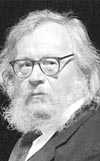|
Editor: (Owen Daly) Artaud
and Grotowski were both originators, explorers in the theatre. This
email gave me a chance to address the similarities and differences
in their work.
| Q:
I was wondering if you could give me any information on the
work of Antonin Artuad and Grotowski, I want to know about theraputic
theatre in perticular( or the Holy theatre) Thank you! Allison |
A: For
Grotowski's thoughts on Artaud you should read his article from
1967 published in "Towards a Poor
Theatre", (pp. 117-125) entitled "He Wasn't Entirely
Himself".
Artaud
died when Grotowski was about 14 years old, so they clearly never
met. Grotowski knew about Artaud and his theory of a Theatre
of Cruelty well before it was used as the guiding technique of the
Royal Shakespeare Company's highly acclaimed production of Marat/Sade
in
1964(written
by Peter Weiss and directed by Peter Brook), a time when Grotowski's
work was beginning to receive wide recognition in the theatrical
world.
Grotowski was not a surrealist, as Artaud
is often described. Some common ground might be found in the
concept of symbolist drama, but I believe their approaches were
very different.
My take on Artaud is that he was very 'out
there' with the idea of living life to the fullest, and that led
him into cruelty because as you observed it or reacted to it you
were at least vitally alive. Many consider that Artaud's creativity
was closely aligned with his mental illness.
Grotowski was in comparison a very reserved
man, and was considered as sane as anyone involved in theatre can
be. Grotowski was interested in archetypes; movements, sounds
and situations basic to the human condition and broadly understandable
across human cultures. He used them as powerful tools for
his actors to communicate with the audience at a very basic level.
Perhaps this is similar to Artaud's symbolist drama, perhaps not.
Both Grotowski and Artaud looked to symbolism and ritual as
theatrical sources, but they developed and employed them differently.
Artaud's theatre might be seen as therapeutic
because it entails 'acting out' and might be cathartic for the actor
or the audience, breaking free of restrictions that keep one from
being fully alive.
Grotowski's technique of working with the
actor who 'makes a gift of himself' is reminiscent of psychoanalysis,
as the patient freely talks about whatever enters his mind, but
this is not what working with the technique was like in practice,
nor would Grotowski agree that this was in any way an objective
of the work. In rehearsal the actors work from within themselves,
concentrating on the physical movements in an almost meditative
manner. Grotowski, as the director, would suggest and guide, and
would ultimately select the movements and sounds that would continue
to be part of the work in progress. I believe he was fascinated
with this creative aspect of the rehearsal process, and as he moved
more away from directing public performances after 1973, he was
ultimately more interested in the rehearsal process than the performance.
In reference to the idea of 'Holy' as applied
to theatre, again they had different approaches. Artaud's
'Holy Theatre', to me, seems holy in the way that the Hindu god
Kali is holy, an awesome power that is both creator and destroyer.
Grotowski's reference to 'Holy Theatre' generally applies
to the dedication of the actor, in giving himself as a gift, an
almost saintly holiness which carries over to a performance which
is transcendent in a much more subtle, human sized way.
-Owen Daly
-Thanks to Anna
Antaramian, formerly Professor in the Communication, Media, & Theatre Department of Northeastern Illinois University, now Professor in the Theatre
Department of Carthage College for correcting my
mistaken reference to Peter Weiss as the Director of Marat/Sade.
-od
|
